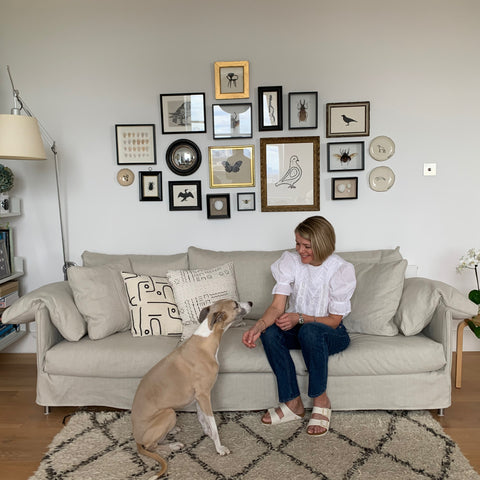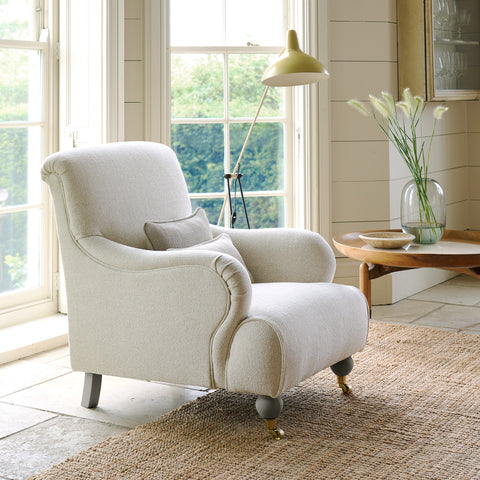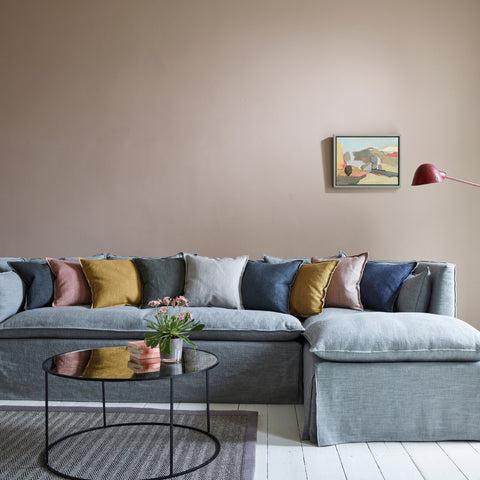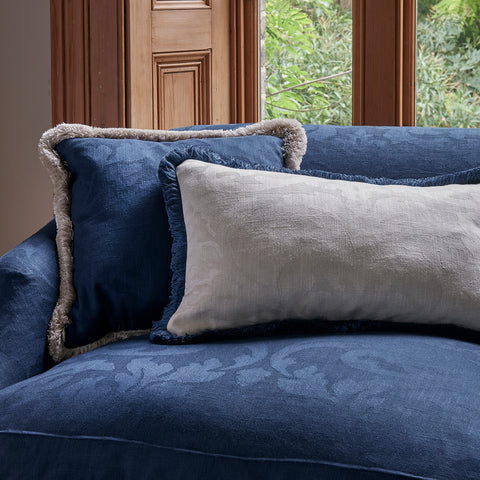It is fair to say that here at Linwood, we love a plain linen. Soft, slubby, sophisticated and sustainable, plain linens bring a feeling of serenity to a space, lending an understated elegance to interiors. Linen is believed to be one of the oldest fabrics in the world, yet it has never gone out of fashion – witness world-renowned designers such as Vincent van Duysen and Axel Vervoordt, who still turn to these tactile textiles to create beautiful, timeless interiors that are the ultimate in quiet sophistication.
At Linwood we offer a wide range of high quality plain linen fabrics to suit all manner of home décor projects, from breezy window dressings to durable upholstery. Here, we explore the many attributes of plain linen, including its eco credentials, its versatility and its easy care…
The beauty of plain linen in your home
Before we go any further, I should confess that I’m a fully paid-up convert to plain linen. It all began many years ago when I was features editor of Elle Decoration in Hong Kong and I needed upholstery for my apartment that looked good and could keep us cool on the muggiest of days (because yes, air conditioning units do break down). I had a sofa and an armchair made to order with slip covers in natural linens and I have never looked back.
If I’m honest, back then I don’t think I was fully aware of linen’s stellar eco credentials, but over time, and as the need for sustainability in interiors became ever more important, I discovered the vital role linen plays within the world of responsible fabrics. Made from the hardy flax plant, which grows naturally in poor soil and requires little more than rain water to cultivate, linen has a much lower environmental impact than water-intensive crops such as cotton, and it is inherently strong as well as being fully biodegradable. Its breathability is another massive draw, as it wicks moisture away from the skin, which explains why linen is so popular in summer wardrobes – and homes. And then of course there are its looks: linen has a subtle texture that brings a relaxed sophistication to interiors. It never looks too showy, yet it still looks good in the chicest of homes.
My love affair with linen has never dwindled, the above sofa being my latest project. I had owned this classic Italian design – the Chemise by Living Divani – since 2012, but after years of use, including by our whippet who deems dog beds decidedly passé, the slipcovers were looking somewhat the worse for wear. I had them remade in Linwood’s Elba, a relaxed, tumbled linen that chimes perfectly with our informal way of living. The warm grey shade, Dove, is remarkably forgiving when it comes to pale dog hairs and aligns nicely with the natural, somewhat Scandi palette of our home. And the best part? The whole lot can go in the machine on a cool, gentle wash, meaning that when I come home to find a horde of teenagers – and of course the dog – holding court on my beloved sofa, I can still breathe…
Choosing the right plain linen for your space
So, how do you select the best plain linen for your project? It’s important not only to consider aesthetics but also to think about how suitable the fabric will be for its purpose. Soft furnishings such as curtains and blinds will receive limited wear, so if you like a breezy linen with a beautiful drape, have a look at a collection such as Danube which features a number of pure linen options including textural twills.
For upholstery, think carefully about how much use the piece will get. A headboard or ottoman might receive light wear but a favourite sofa or armchair will need to stand up to constant use and thus require a fabric with a high Martindale rub test (this test measures the durability of a fabric). As well as pure linen fabrics, Linwood offers a number of collections that combine linen with other yarns such as viscose to provide added strength, and these ranges cater to both lovers of bold, bright colours as well as homeowners who prefer quiet neutrals. Juno, for example, is a clever, stain-resistant linen blend weave that comes in more than a hundred colours, from shades of cream to pastels and punchy brights; Orta, meanwhile, is our tumbled, heavy-weight linen blend fabric that is available in an earthy palette of natural shades. Serrano is another collection of plain linen fabrics in timeless neutral tones: pictured here is Sienna in Almond, a textural bouclé made from linen, cotton and viscose that is fabulous to the touch yet contract grade – meaning that it should last for years to come.
Creative ways to incorporate plain linen
There is nothing dull about a plain linen. The texture of the fabric gives it character, making it the secret weapon of designers who like to create layered, tactile interiors. Plain linens look fantastic used in tone-on-tone schemes – think linens in natural shades for a serene bedroom scheme, utilising a variety of different weights and textures for the headboard, bedcover, cushions and curtains, for example – while linens that share the same ‘colour lexicon’ are another wonderful basis for a scheme: witness this sitting room that layers linens in an array of warming spice hues, all from the Elba collection.
You can also use plain linens to offset dynamic printed fabrics, balancing the energy of a bold pattern with plain linen fabrics that pick out the colours within the design. The beauty of all plain linens is that, thanks to their textural qualities, they carry colour beautifully, giving the fabric depth and character.
DIY home décor projects with plain linen
The soft handle of linen makes it a fantastic candidate for DIY projects – and I say this with some authority having just completed a Roman blind, again using pure linen from the fabulous Elba collection. If you have basic knowledge of a sewing machine, projects such as cushion covers, tablecloths and simple curtains and blinds should all be within your reach, and the beauty of the internet is that any forgotten techniques can quickly be relearnt (I had to remind myself how to create mitred corners for my Roman blind, a technique that is also useful if you are making tablecloths or placemats).
Slipcovers are a somewhat more ambitious project, particularly if you are making them for a large piece such as the modular sofa pictured above, but the cushions should be a cinch, and don’t worry if you don’t know how to put in a zip: simply overlap two pieces of fabric at the back to create the opening, adding press studs if required. The cushions pictured here feature a narrow Oxford edge, a simple yet lovely detail that is achieved by making the cushion a little larger than required (say, an extra 1.5cm on each edge) and then sewing the little border once the piece has been turned to the right side (do iron it first, to ensure a neat finish). Both the cushions and slipcovers are made in Luna, a blended linen weave that is both durable and soft to the touch. Its washed finish gives all the colours a slightly vintage feel, perfect for a casual aesthetic.
Maximising the potential of plain linen
A plain linen fabric is fabulous in its own right but there are some clever tricks you can employ to enhance its natural beauty. We have already discussed how different weights of linen fabrics give a room a layered feel: combine thick, chunky upholstery linens with lighter linen fabrics for, say, curtains, cushions and tablecloths, allowing the varying textures to play off against each other.
It’s also a lovely idea to use customised finishes to draw attention to a beautiful plain linen: think antiqued brass studs to outline a linen headboard, for example, or tufting on a linen ottoman to give added character to the piece. Here, the pleats on the scrolled arm of the sofa draw the eye to the rich texture of the fabric, a linen mix from our Orta collection. The designer Angus Reid recently created bar stools for a country kitchen that combined leather upholstery with backs in a rustic sackcloth. The characterful linen, which was not unlike Linwood’s Sackcloth – which, by the way, comes in a handy one metre width – was a lovely contrast to the more practical leather and offered an ingenious way to bring all-important texture right into the heart of the kitchen.
Caring for your linen
You can ensure the beauty and longevity of Linwood’s linen fabrics by following a few simple steps:
Like all fabrics, linen soft furnishings benefit from regular vacuuming. Use the upholstery brush attachment, while the crevice device is ideal for getting into the nooks and crannies of sofas and armchairs.
Plumping cushions, including seat and back cushions, helps eliminate dust, which is the main culprit for upholstery appearing lacklustre.
Always check the care label. Some of our linen fabrics can be machine washed on a gentle cycle. Allow for up to 3% shrinkage and carefully reshape the covers whilst damp. It is advisable to also iron covers (on the reverse side) whilst still damp.
Our linen mix fabrics, including this stylish Miletto damask, are dry clean only, so you need to contact a specialist upholstery cleaner. Avoid trying to spot clean, and instead, blot up any spills with a soft, lint-free cloth before contacting a professional.
Always have all your covers or curtains in the same fabric cleaned in one go, to avoid colour discrepancies.
I hope you have been inspired to dive into Linwood’s collections of plain linen fabrics for your next interiors project. You will quickly discover just how versatile these timeless fabrics are, bringing a natural beauty to all manner of interiors. Don’t hesitate to order samples to see how different textures will work together – and let this lovely, natural fabric capture your imagination.






